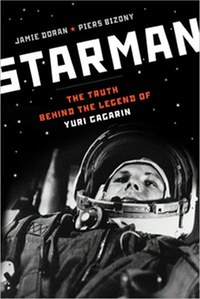Review: Starmanby Jeff Foust
|
| “Gagarin’s social responsibilities began the instant his feet touched the ground,” they write. |
Starman tells the life story of Gagarin, who grew up on a farm to the west of Moscow, occupied for a time during the Second World War by the Germans. (The book makes out the young Gagarin to be something of a pint-sized resistance fighter, sabotaging batteries used by German vehicles.) Gagarin’s interest in aviation, dating back to a chance encounter with Soviet aircraft during the war, was reignited by joining an aviation club while in a technical school studying tractors; this led to going to military flight school and becoming a fighter pilot in the Soviet Air Force. In 1960, he was selected as part of the first group of 20 cosmonauts, emerging soon thereafter as one of the leading candidates for that flight, along with Gherman Titov (who would make the second Soviet spaceflight later in 1961).
While much is known about Gagarin’s flight, the book devotes considerable attention to what happened afterwards. “Gagarin’s social responsibilities began the instant his feet touched the ground,” they write, and what followed was a whirlwind of social and political appearances, at home and around the world. The book suggests these appearances took a personal toll on Gagarin, with heavy drinking and rumors of infidelity, including being hospitalized for a head injury after leaping from a second-floor balcony of a Crimean dacha to evade his wife, who suspected he was in bed with a nurse. Gagarin, after years of non-flight duty, was attempting to regain his flight proficiency when the MiG trainer he and a flight instructor were flying crashed in 1968, killing them both. The authors do not subscribe to any of the conspiracy theories surrounding Gagarin’s death, suggesting that it may have been an accident caused by a combination several factors, including a loss of control of their MiG after encountering the backwash of a passing supersonic jet.
Most of the attention surrounding Starman is associated less with Gagarin’s life than a passage about the death of Vladimir Komarov on Soyuz 1, a mission on which Gagarin served as the backup cosmonaut. NPR’s Robert Krulwich, citing the book, described in a blog post last month both the tragic flight (including claims that Komarov was “crying in rage” during his ill-fated reentry) as well as assertions that Komarov, aware of the flaws with the new Soyuz flight, accepted the mission to protect his backup, Gagarin. The former claims date all the way back to reports from the 1970s by one individual, Perry Fellwock, that the NSA had monitored radio transmissions between Komarov and the ground; others have argued that while such eavesdropping was likely, Fellwock probably embellished the content of the transmissions. The latter claims rely on the word of a former KGB handler of Gagarin, Venyamin Russayev, who spoke with the authors “after lengthy and delicate negotiations,” according to the book’s foreword. Historians of the Soviet space program have challenged this, noting that Russayev’s claims run counter to other evidence from the period.
| In one passage, they use the present tense when talking about “white-haired 63-year-old Gherman Titov,” who would in fact be 75 years old now but passed away in 2000. |
The irony of this debate is that Starman is not a new book. It was first published in the UK in 1998; this reprinting marks the first time the book was also published in the US. A new afterword in this edition gives no evidence that the authors added new material to this edition. Instead, they remark on the window of opportunity they were able to take advantage of in post-Soviet Russia in the 1990s to get sources to speak openly for the first time. At least some portions of the book appear untouched from its original edition. In two places the authors state that a descendent of the R-7 rocket used to launch Gagarin is still used today for Soyuz missions to Mir, a space station that was deorbited a decade ago. In another passage, they use the present tense when talking about “white-haired 63-year-old Gherman Titov,” who would in fact be 75 years old now but passed away in 2000 (his passing is mentioned in the book’s afterword.)
So, does Starman live up to its subtitle and describe the “truth” about the life of Yuri Gagarin? As the controversy above about the book’s Komarov passages suggests, there is still plenty of uncertainty and debate about the life of the world’s first space traveler. This book is unlikely to be the last word—the ultimate truth, if you will—about Gagarin.
